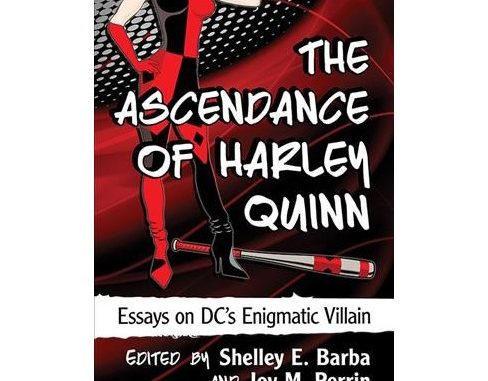
Review Fix chats with Shelley Barba and Joy Perrin, who discuss the creative process behind their new book, “The Ascendance of Harley Quinn: Essays on DC’s Enigmatic Villain.â€
About the Book:
Since her first appearance in 1992, Harley Quinn–eccentric sidekick to the Joker–has captured the attention of readers like few new characters have in eight decades of Batman comics. Her bubbly yet malicious persona has earned her a loyal and growing fan base as she has crossed over into television, theater, video games, and film.
In this collection of new essays, contributors explore her various iterations, focusing on her origin and contexts, the implications of her abusive relationship with the Joker, her relationships with other characters, her representations across media, and the philosophic basis of her character.
Review Fix: How was this project born?
Shelley Barba: We saw some other great collections of scholarly essays on comic book characters and realized there wasn’t one on Harley Quinn, which is crazy because she’s a complex character that’s very appropriate for the time.
Review Fix: What was the research process like?
Joy Perrin: We spent a few years reading every comic book we could get our hands on and watching the Batman: The Animated Series just to get a baseline. We started on a Mediography of Harley Quinn to record her major appearances and story arcs. Then we brainstormed various aspects of the character people could write on and solicited essays.
Review Fix: What were your initial goals for the book? Did you succeed?
Barba: Our primary goal for the book was to give Harley Quinn fans a place for academic engagement. We saw the character as multi-layered and complex and thought surely other people would think that as well. We feel we succeeded and are very happy with the articles that the authors produced and the variety of academic disciplines covered.
Review Fix: Why does Harley Quinn matter?
Perrin: Our western society doesn’t do a great job of handling people on the edges. Harley Quinn is dualistic by nature. She’s both good and bad. She’s bisexual and non-monogamous, both identities existing between normal labels. She’s important because the character is a mirror of society in a way that comic book heroes can’t be. Because she exists between villain and hero, she can get away with trying more things, and so readers and viewers get to decide if what she does is really bad or good. For example, the relationship of Harley Quinn and The Joker — why do some romanticize the couple, while others recoil away?
Review Fix: What comics did you read as a kid?
Barba: Interestingly enough, we didn’t read comics. We watched Batman: The Animated Series, and that was our first introduction to the characters. Since then, we’ve gotten into a variety of comics.
Review Fix: How has Harley affected you as a reader and person?
Perrin: Well, Joy studied Psychology and then gave up to become a supervillain… wait… never mind. Harley Quinn was one of the few complex female characters we had growing up in the early 1990s. So much of kids programming has the Token Girl, giving us only one person to try to identify with, and if we don’t– then tough luck. Batman: the Animated Series had many complex female characters, and Harley Quinn was really fun. She is resilient and smart, though she doesn’t act like it all the time.
Review Fix: What do you think is the book’s biggest success?
Barba: The biggest success is the fact that we got submissions from so many different areas of study. If someone can read this book and be introduced to a field of academia and find out that they like it, and that introduction happened because of Harley Quinn, that’s remarkable.
Review Fix: What did you learn through this book that you didn’t expect to?
Perrin: I learned about hybristophilia, which I hadn’t heard of before.  A few people have taken stabs at trying to diagnose Harley Quinn with something, and nothing really truly fits, but that one does it. It explains why she likes the Joker and Poison Ivy. We also learned that comic books are a nightmare to cite in a consistent way. There are so many iterations and printings of Mad Love, it can get very confusing when editing late at night!
Review Fix: Any other interesting stories that you’d like to share?
Barba: When we were editing the book, a lot of authors cited the New 52 comic books by listing Jimmy Palmiotti first when Amana Conner comes first on the cover, and on the title page, and alphabetically. I’d like to point out that on Amazon, the first issue of the new series, Jimmy Palmiotti is listed as the author and Amana Conner is listed as the Illustrator, despite the fact that on the title page it says “written by Amanda Conner & Jimmy Palmiottiâ€. They’re married, but that doesn’t mean his name should come first! It felt ironic, given the context of the book and the subject matter.
When we were doing the index, we were going to index the Joker but then we realized there were only two sections in the whole book that didn’t mention him, so we decided to not index his name. It goes to show just how connected the two are.
One of the fun things about working on this book was working with so many authors from various countries. We realized that as we were sending the author copies out how many different areas of the world were represented in that book.
Review Fix: How would you like this book to affect people?
Perrin: Read the articles that sound interesting to you, and hopefully when you watch a show or read a comic book, you realize that media is not just stories. Comic books are not just entertainment. They’re our modern mythology. Yes, they can be entertaining, but when something happens to the characters that resonate with people in the real world, maybe look into why that happened. Be more curious about the media you consume and the values it’s portraying.
Review Fix: Who do you think will enjoy it the most?
Barba: We hope Harley Quinn fans will really enjoy the book. I don’t think it was designed to make someone a fan, however, if you already like the character, the book points out the depth that is already there.
Review Fix: Bottom line, why must someone read it?
Perrin: The chapter by Ian Barba actually makes this argument about video games, but I think it extends to media as a whole. The stories that entrain us are telling us something. Sometimes those messages are subtle, and when you’re immersed in a story or a video game you may not be thinking about it. A lot of the book touches on the comic book Mad Love, which is a seminal work for Harley Quinn’s story, and the book demonstrates that a simple story can mean so much. I want people to stop and consider what they’re consuming, even if just for a bit, to think about if they agree or disagree with the message. When we had people test read the book, we got comments about the chapters being contradictory. One chapter claimed one thing, and another would claim the opposite. This is what art does – sparks debate about what the story really means and what the reader agrees with and what they didn’t. Consume media mindfully and realize there is depth in stories that may seem just for entertainment.
Review Fix: What’s next?
Barba: We encourage everyone to follow the authors that participated in the book. It’s nice to have the attention come to us, but the authors were the real brains behind the content.
Review Fix: Anything else you’d like to add?
Perrin: As much as we love Harley Quinn, we’d both like to never read Mad Love again. While it is important, it’s also just difficult to watch her be treated that way when there are happier and more interesting times for the character.


Leave a Reply